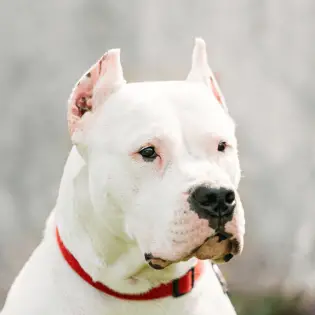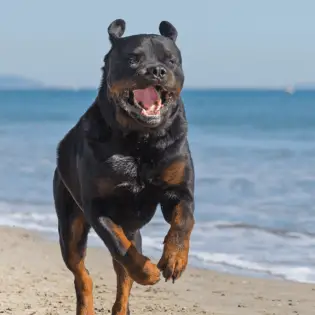Bracco Italiano
The Bracco Italiano, as their name suggests, is an Italian breed primarily bred as a hunting dog. This is also among the oldest hunting breeds; historical evidence places them in 400 - 500 years B.C. They might be bred for hunting, but as hunting started to lose popularity, these dogs took a different role - the role of a beloved family pet.
The Bracco, as it is often called, is an affectionate breed that gets along with every single family member. They are adaptable and will quickly get used to all living conditions. Still, they prefer living in households with large, fenced yards that can provide them with a safe place for roaming and exploring.

Height:
21–27 in (53–69 cm)

Weight:
55–90 lb (25–41 kg)

Origin:
Italy

Life Expectancy:
10-14 years
Dog Breed Characteristics
Appearance
The Bracco is a pretty large dog with a typical height of 21 - 27 inches at the withers and a weight of 55 - 90 pounds. There should be a slight difference in height between male and female dogs, and the weight should be in line with the height. These dogs have a small dewlap on their necks.
Legs in the front need to be sturdy and straight. The top line of the body should be slightly sloping and then rise again towards the back end, giving it a square appearance. Muscular and straight rear legs with well-angled stifles are ideal. It's common for a dog's tail to be docked, but when undocked, the tail should be held at the same level as the body.
Long and wide, the breed's head has a distinct appearance. An ideal muzzle length equals the skull's circumference, with a large, prominent nose. A perfect head circumference is slightly less than one-half of the height at the withers. These dogs need to have a strong jaw with a perfect scissor bite and flat cheeks.
The eyes should be large and oval-shaped, with a soft expression. It has long, low ears that meet at the level of the eyeballs. They should broaden from the base and easily reach their noses.
There should be plenty of drive and power in the Bracco Italiano's gait. Dogs should be able to trot at a fast pace for extended periods while keeping their head held high.
Coat type and color
These dogs have short, glossy coats that should be fairly soft. The hair should lay close to the skin. The breed's standard allows several coat colors, and the most common ones are;
- Brown
- Roan
- Chestnut
- Chestnut Roan
- Orange
- Orange & White
- Orange Roan
- White
- White & Amber
- White & Chestnut
- White & Orange

Temperament
The Bracco Italiano shares a deep affection for their human companions. Those who live in the country, they make excellent hunting and working companions, but they are also loving and affectionate indoors, where they enjoy cuddling and unwinding together with you. Playing games in the yard is their favorite pastime. However, they require a confident and knowledgeable trainer to get the most out of them.
Meeting new people is also a breeze for the Bracco Italiano. Because they were initially created to detect and pursue games, they have a strong prey drive. Still, at home, they will love nothing more than to relax next to their favorite humans. They're not made to be watchdogs, as they don't bark very often. Large and beautiful, these pups are also loyal and loving to their owners.
Separation anxiety can set in if you leave them alone for an extended period of time. You should take them on long walks to help them burn off their excess energy. As a result, these dogs are suitable for families and homes of all sizes.
Care guide
The Bracco is a fairly large hunting dog, which means it should be pretty easy to maintain. However, these days, they have taken on a new role; that of a family pet. That means their needs have changed, and their owners need to provide them with the same things other large breeds need. Here are the most important parts of Bracco Italiano care.
Grooming
The short, glossy hair of the charming Bracco Italiano is simple to maintain. Brush your dog with a boar-bristle brush or a grooming glove a few times a week to remove the loose hair and prevent it from making a mess. Braccos are famous droolers, so owners who can't put up with their pet's messy drooling habits should avoid getting one of these dogs.
Because of its long ears, the Bracco Italiano can develop ear infections quicker and more often than other breeds. The ears of floppy-eared dogs create ideal environments for yeast and bacteria, so owners should inspect and clean them regularly. Clean the ears with a soft cloth and ear cleaners, and avoid cotton swabs, which can cause damage to the dog's inner ear parts. Owners should keep their dogs' nails at a reasonable length.
Another important aspect that often gets overlooked is dental hygiene. You should brush your dog's teeth at least a couple of times a week. This habit will go a long way in preventing dental issues and bad breath.

Training
The Bracco Italiano is a quick learner and eager to please their owners. Quick to grasp the task at hand and with exceptional scenting abilities, the breed continues to be an excellent working dog. Recall and house training are usually not a problem because of their eagerness. The breed's history, however, should not be overlooked.
These dogs can easily pick up an interesting scent, at which time their instincts take over, and they will follow it with little to no regard for their owner's commands. Unfortunately, many dog owners learned that lesson the hard way.
Exercise needs
Despite their size and athleticism, the Bracco Italiano is obedient and calm in the house if it gets enough regular exercise. Owners should set aside at least 90 minutes a day for vigorous activities like scent tracking. However, activities like running, power walking, or even swimming can also be good options to meet this breed's daily exercise needs.
The Bracco Italiano will become bored if they don't have a proper energy outlet. That usually results in destructive behavior in the house.

Socialization
The Bracco Italiano comes from a hunting background, so many potential owners avoid them because they have some misconceptions about the Bracco's temperament. These dogs are naturally docile and calm, making them a joy to socialize. This is a necessary process, and for this breed, socialization should focus on preventing shy temperaments.
Make sure you take your Bracco to busy dog parks and other places where they'll have a chance to interact with strange dogs and people. Keep the experience positive, and your dog will soon learn strange dogs, and people are nothing to be afraid of.
Bracco Italiano and kids
Children love the Bracco Italiano's upbeat demeanor, which makes them great playmates for years to come. In spite of their protectiveness, they always appear to be gentle with children. Having fun with people of all ages is something these dogs absolutely adore. However, always keep an eye on your pet and your children when playing.
A quick response is the only way to prevent both sides from being injured.
Bracco Italiano and other pets
Braccos can quickly learn to get along great with other dogs if socialization begins early enough. They can also get along with domestic cats, but only if they are taught to do so early. As a precautionary measure, you should never leave your dog and your cat alone. Remember that Bracco Italiano is a hunting dog with a high prey drive.
That means they should not be trusted with rabbits or other small pets such as ferrets, hamsters, or guinea pigs.
Health
The Bracco may share the same potential health issues as other pointing breeds. The average lifespan of this breed is between 10 and 14 years, but individual dogs can be more susceptible to specific health problems, so it's crucial to provide them with adequate care and have regular veterinary examinations. The Bracco Italiano has a wide range of possible health issues, including:
- Hip dysplasia - This condition refers to improper hip joint development. It can be hereditary or caused by developmental issues and trauma.
- Cherry eye - When the third eyelid protrudes, it can give the appearance of a cherry. This condition is common in dogs with oversized eyes.
- Elbow dysplasia - An abnormal growth of the elbows causes osteoarthritis and lameness over time.
- Ear infections - Check your dog's ears frequently for signs of infection or redness, especially if they enjoy swimming or playing in the water.
- Entropion - A defect causing the eyelid to roll inward.
- Ectropion - A defect causing the eyelid to roll out or sag.
- Obesity - Bracco is prone to obesity if they are not adequately exercised
Bracco Italiano breeders
No matter which dog breed you're looking for, the best thing you can do is look for a reputable breeder. The same is true for getting a Bracco Italiano. These dogs are prone to diseases, and the dog's chance of developing some of those diseases increases. You should find a reputable Bracco Italiano breeder and ask them about available puppies. You can also ask them all the questions about the breed, and we are sure they will give you plenty of helpful information and tips.
SEARCH BRACCO ITALIANO BREEDERS
World Dog Finder team

Updated at31.08.2023.
Breed History
Italy's Bracco Italiano is the oldest European Pointer, a large dog breed that originated there. Pictures of dogs that look like the Bracco Italiano were dated to 400 years B.C., and Italian Renaissance frescoes from the 14th century depict canines that look like this breed. Bracco Italiano was initially considered a cross between the Asiatic Mastiff and Segugio Italiano.
The famous Italian families Medici and Gonzaga bred these hunting dogs, popularizing them with the Italian nobles. In the past, they were used to drive game into large nets hunters set or held or chase birds that were being hunted by falconers. The Bracco was later used by hunters when firearms were introduced.
At the beginning of the 20th century, the Bracco Italiano population began to decline. The breed was revived by Ferdinando Delor de Ferrabouc, a famous Italian Bracco breeder who founded the Societa Amitori Bracco Italiano. Even though they are no longer used as hunting or working companions, the breed is still popular across Europe and the US.
The UKC (United Kennel Club) registered this breed in 2006. Only a year later, the Bracco Italiano Club of America was established. Their goals are to further develop the breed and get official recognition in the United States.














Share